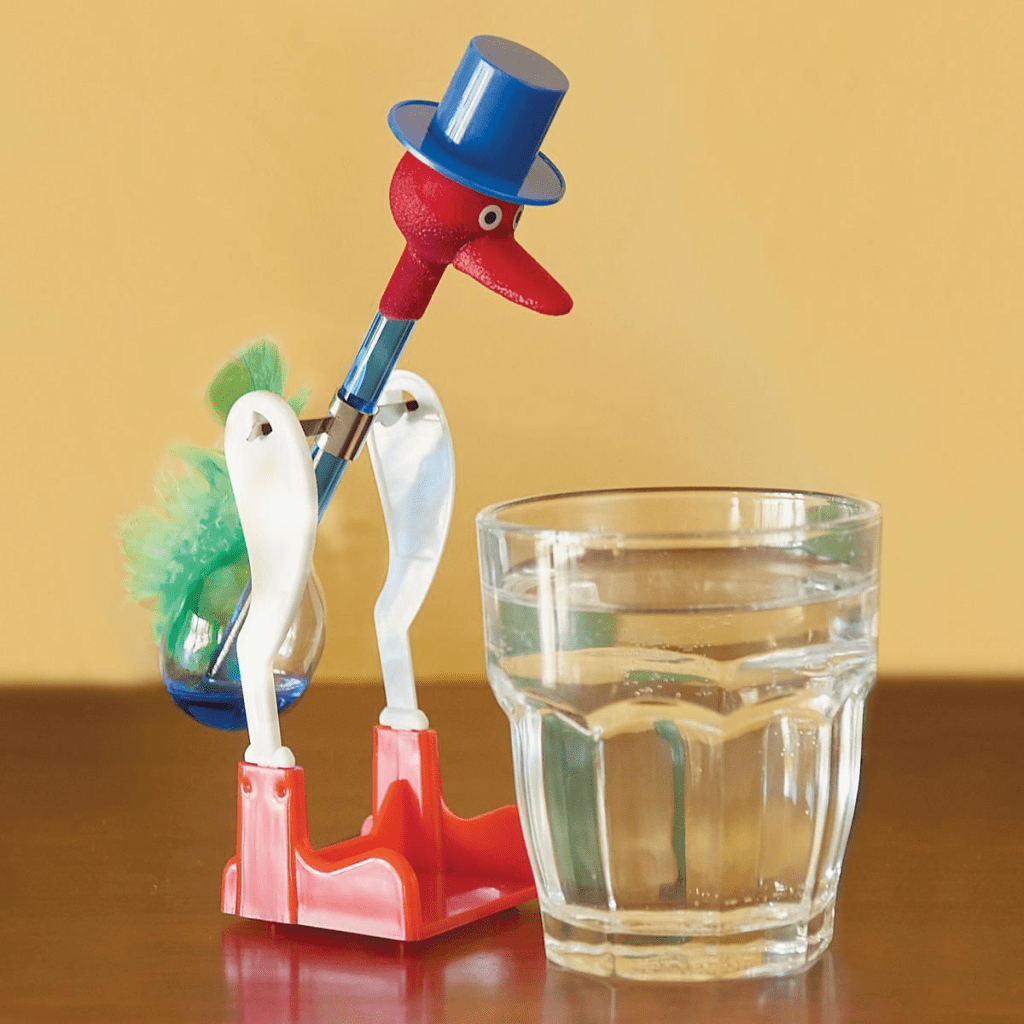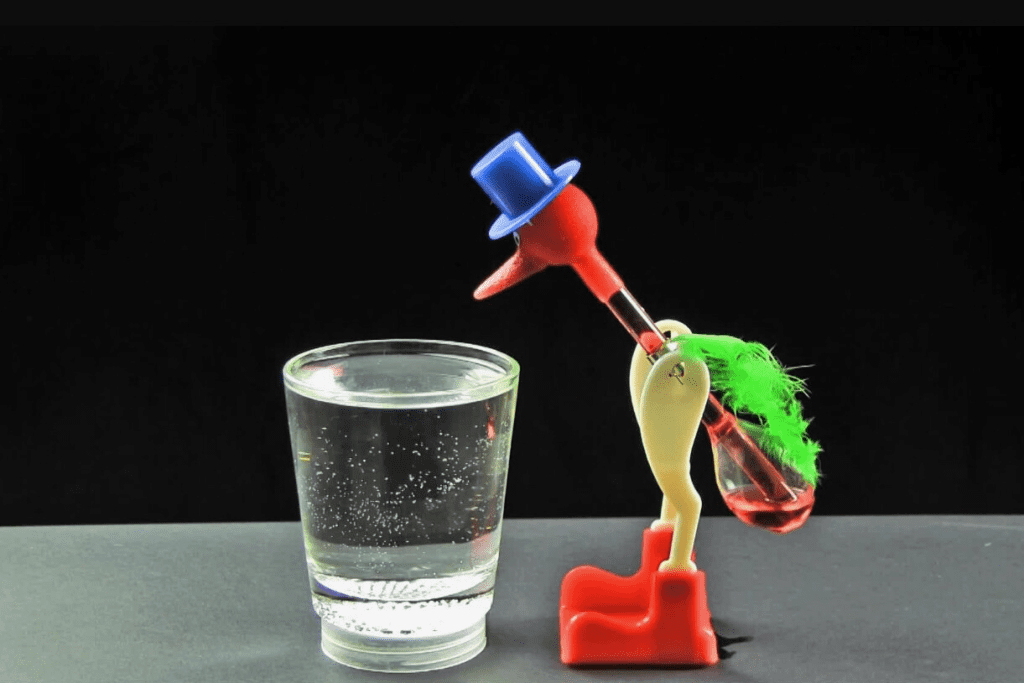The drinking bird, also known as the dippy bird, sippy bird, or dipping bird, is a novelty item that has captured the curiosity of generations. It’s more than just a whimsical desk toy; it’s a fascinating example of applied science, utilizing thermodynamics and fluid dynamics to produce a seemingly perpetual bobbing motion. Often seen as a quirky decoration, the drinking bird actually serves as an educational model, demonstrating complex scientific principles in a fun and engaging way.

What is a Drinking Bird?
A drinking bird is a simple heat engine that operates by continuously dipping its beak into a glass of water and returning to an upright position, creating the illusion of drinking. The bird’s movements are powered by a temperature difference between its head and body, which allows it to repeatedly tip forward and rise back up. This cycle continues as long as the bird’s head remains damp, making it appear as if it has an endless thirst.
Though often mistaken as a perpetual motion machine, the drinking bird does not violate the laws of thermodynamics; it requires energy in the form of evaporating water to sustain its motion. The toy is constructed with two glass bulbs connected by a tube, filled with a volatile fluid that drives its unique mechanism.
The Origins and Popularity of the Drinking Bird
The invention of the drinking bird can be traced back to the early 20th century. The modern version was refined by chemist Miles V. Sullivan in the 1940s while working at Bell Telephone Laboratories. Although similar devices existed in earlier decades, Sullivan’s improvements helped popularize the toy, making it a staple in homes, classrooms, and laboratories.
The drinking bird became a cultural icon, featured in movies, TV shows, and even classrooms to illustrate fundamental scientific concepts. It gained widespread appeal not only for its educational value but also for its charm, with its quirky motion and simple design capturing the imagination of all ages.
How the Drinking Bird Works: The Science Explained
The drinking bird operates through the principles of thermodynamics, fluid dynamics, and evaporation. Here’s a breakdown of its mechanism:
1. Evaporation and Cooling
The drinking bird’s head is covered in felt, which soaks up water when it dips into a glass. As the water evaporates from the felt, the temperature in the head bulb decreases due to the heat of vaporization. This cooling effect causes the volatile liquid (typically methylene chloride) inside the head to condense, reducing the pressure in the upper bulb.
2. Pressure Difference
With the pressure in the head reduced, the higher pressure in the bottom bulb pushes the liquid up the tube (the bird’s neck). This shift in liquid makes the bird top-heavy, causing it to tip forward, which is why it appears to “drink” from the glass.

3. Resetting the Cycle
When the bird dips forward, a small amount of the liquid returns to the bottom bulb, balancing the pressure difference and allowing the bird to return to its upright position. As long as the head remains wet and the temperature differential is maintained, the cycle will continue.
This process demonstrates several physical principles, including the combined gas law, heat of vaporization, and the ideal gas law, making it an excellent educational tool.
Educational Value of the Drinking Bird
The drinking bird is often used in classrooms to illustrate various scientific concepts, including:
- Thermodynamics and Heat Engines: It’s a simple yet effective model of a heat engine, converting thermal energy into mechanical work.
- Evaporation and Condensation: The cycle of liquid rising and falling in the bird’s body illustrates phase changes and pressure differences.
- Gas Laws: The relationship between temperature, pressure, and volume is visible in the bird’s motion.
- Center of Mass and Torque: The tipping motion demonstrates principles of balance and rotation, making it a useful tool for physics lessons.
Is the Drinking Bird Safe?
While the drinking bird is safe when intact, it contains methylene chloride, a volatile chemical that can cause skin irritation and is potentially harmful if inhaled or ingested. In case of breakage, it’s essential to ventilate the area and avoid direct contact with the liquid inside.
Older models of the drinking bird contained flammable fluids, but modern versions use safer alternatives. Still, it’s best to handle this toy with care and keep it out of reach of young children.

Drinking Bird in Popular Culture
The drinking bird has appeared in several pop culture contexts, enhancing its appeal beyond just a scientific curiosity. Notable appearances include:
- Movies and TV Shows: The drinking bird was famously featured in the comedy film Airplane!, humorously used as an autopilot indicator. It also appeared in the animated show The Simpsons, where Homer Simpson uses it to press a computer key repeatedly, leading to chaotic results.
- Classroom Demonstrations: Many science teachers use the drinking bird in lessons to illustrate complex concepts in an engaging way, making physics and chemistry accessible to students.
- Collectibles: Vintage versions of the drinking bird are now collectibles, cherished for their nostalgic value and unique designs.
The Drinking Bird as a Collectible and Nostalgic Item
For many, the drinking bird is a reminder of childhood fascination, a toy that entertained while subtly teaching about the science of motion and energy. Vintage models, particularly those with unique designs or colors, have become sought-after collectibles. Collectors appreciate the craftsmanship and simplicity of the device, often adding it to displays that celebrate novelty items from the mid-20th century.
How the Drinking Bird Differs from a Perpetual Motion Machine
It’s a common misconception to think of the drinking bird as a perpetual motion device, but this isn’t the case. Perpetual motion machines are theoretically impossible because they would violate the laws of thermodynamics by producing work without energy input. The drinking bird, however, requires a continual energy source—evaporation of water from its beak—to maintain its motion. When the water runs out, or if there’s no temperature differential, the bird stops.
Modern Variations of the Drinking Bird
While the classic design remains popular, modern variations have been developed to operate using capillary action instead of a volatile liquid. These versions work by wicking water up through a sponge in the beak, eliminating the need for a temperature differential. Although slower in movement, these newer models maintain the mesmerizing bobbing action and continue to captivate onlookers.
Conclusion: The Enduring Appeal of the Drinking Bird
The drinking bird is much more than a desk toy; it’s a clever device that beautifully illustrates scientific principles in a playful and accessible way. From its humble beginnings to its status as a pop culture icon, the drinking bird has charmed and educated generations. Its rhythmic motion serves as a reminder of the simplicity and elegance of basic physics, sparking curiosity and wonder in both young and old.
Whether you view it as an educational tool, a collectible, or simply a nostalgic novelty, the drinking bird remains an enchanting example of the intersection between science and play, ensuring its place in the annals of novelty history.


